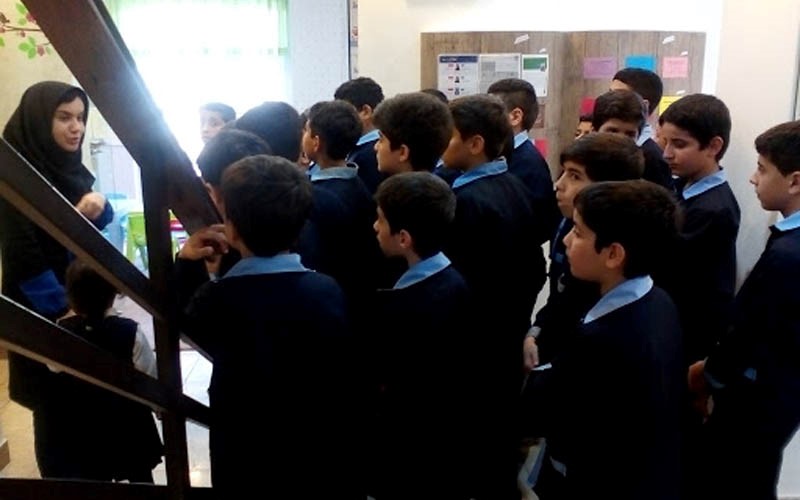
By Jubin Katiraie
On September 12, Iranian media outlets reported 39 school students had been infected with the novel coronavirus in a town in Lorestan province. Also, on September 13, Asr-e Iran daily acknowledged that the death of an eight-year-old student of the Covid-19 had caused concern among parents in Gotvand county in Khuzestan province.
Afshin Torkarani, acting governor of Selseleh town in the Delfan region, announced that these students were educating in different grades. “From September 5 to yesterday [September 11], 39 students in different educating-grades contracted the novel coronavirus,” Lorestan’s official telegram channel quoted him as saying.
According to reports, only during September 10 and 11, at least 18 students were infected with the virus in this area. Given this event, Torkarani announced that all schools in Alashtar and Firuzabad counties would shut down until October 10.
Locals say the rest of the patients were among students of primary schools. However, the acting governor realized that the infected students are between 7-17 years old. He affirmed that all of them were those who attended in-person schools.
Furthermore, in recent weeks, Lorestan province experience critical conditions. Seyyed Mousa Khademi, the provincial governor, recently said, “Regrettably, Lorestan province is among provinces that had a leap in the number of new hospitalized patients.”
He also laid the blame on the people and added that the people probably neglected in obeyance of guidelines, and today, we witness these cases. According to Iranian opposition Mojahedin-e Khalq (MEK), as of September 12, over 4050 people have lost their lives to the Covid-19 in Lorestan. Notably, the Iranian government refuses to acknowledge the number of coronavirus victims divided by province.
In recent months, the Iranian government’s odd function show there is no will among authorities to contain the contagion. In this respect, on July 22, Amangholich Shadmehr, member of the Parliament (Majlis) from Gonbad Kavus in Golestan province, slammed the government’s incompetence decisions.
“Officials are blaming everything on the people. They should be reporting on what they have done and are doing?… The people do not even have the power to purchase face masks. [Officials] should get a hold of themselves! It is as if they have sworn to kill all the people,” he said in a Majlis public session.
Earlier, Deputy Health Minister Iraj Harirchi had admitted that the lifting of restrictions and reopening of crowded centers and sites sank the country to more health catastrophe. “Lifting restrictions resulted in 200 deaths in the span of the last 24 hours. If comprehensive measures are not taken, rest assured our circumstances will deteriorate further,” he said on July 8.
Furthermore, many health officials had lately issued warnings about the reopening of schools and education centers. “With the reopening of schools and other education centers, and an increase in traffic in the city of Tehran, there is a possibility of a rapid spread of coronavirus among families,” Entekhab daily quoted Alireza Zali, the head of Tehran Covid-19 Task Force, on September 1.
Alireza Zali, the head of #Iran's #Coronavirus Taskforce in Tehran, admitted on September 10: The number of people suffering from the #COVID19 in Tehran is increasing exponentially. The situation in the capital is still dangerous and red. pic.twitter.com/TdnfGZNR9h
— Iran Focus (@Iran_Focus) September 10, 2020
Also, a member of the National Coronavirus Task Force, Minoo Mohraz, described schools as “the most dangerous place to transfer” the novel coronavirus. “Even if individuals wearing masks are together in closed environments for a long time, there is a possibility of the illness being transferred to others,” she explained in an interview with Asr-e Iran daily on September 2.
However, President Hassan Rouhani and his education minister Mohsen Haj Mirzaei were insisting on the reopening of in-person schools, which would be ended at the expense of millions’ lives and health of students, teachers, and parents.
This hasty and irresponsible decision caused severe objections among media outlets and health officials. For instance, in an interview with Resalat daily on September 7, a medication strategist Siamak Afazeli described schools’ reopening as a “genocide.”
Also, Anush Barzigar, head of the Gilan Province Medical Apparatus, highlighted the administration’s responsibility for children’s health. “In our viewpoint, those who reopened schools will be responsible for the death of even one student or teacher, and this is an unforgivable mistake,” he said.
A member of Tehran City Council, Shahrbanu Amani, also criticized the reopening of schools. “With 14.7 million students across the country and 2 million going to classes in Tehran, there’s concern that even if one percent of this population contracts coronavirus, we will be faced with a human catastrophe,” she told Arman-e Meli daily on September 13.
Amani also blamed Rouhani for not attending the inauguration ceremonies of schools and universities while he was promoting the reopening of schools and silencing any opposition voices by attributing speakers to foreign “enemies.” “The president didn’t have any plans to attend any of the schools physically and he declared yesterday that he would be attending the inauguration ceremony of universities virtually, and this shows how bad the situation is in Tehran,” she added.
In reality, this is merely the beginning of the story. The hazardous impact of crowded mourning ceremonies, holding college entrance exams without providing essential hygienic protocols, and reopening schools will emerge in upcoming months. Remarkably, the country will be plunged into more disaster due to the contagion of seasonal flu in fall and winter.
“Rushing into reopening schools and sending kids into classrooms as we saw, not having a supervising system and failing to provide necessary training to the teachers will increase the dilemmas ten-fold. The problem is that in late September, in addition to Covid-19, we will also be witnessing flu and cold epidemics,” said Massoud Mardani, a member of the National Covid-19 Task Force, on September 10.


